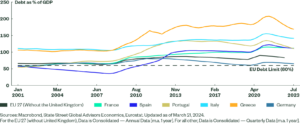By subSPAC
EXECUTIVE SUMMARY
- Luxury brands had a rather fashionable year in 2022, bouncing back from the pandemic slump with the help of pent-up demand and lockdown savings spent on travel-worthy threads.
- However, even the resilient luxury market isn’t immune to the macroeconomic forces at play, from inflation to the war in Ukraine and the impending recession in the US and Europe.
- It is a surprise then that Luxury Fashion house Lanvin Group decided to plunge into the public markets despite the choppy economic waters.
DETAIL
Luxury brands had a rather fashionable year in 2022, bouncing back from the pandemic slump with the help of pent-up demand and lockdown savings spent on travel-worthy threads. However, even the resilient luxury market isn’t immune to the macroeconomic forces at play, from inflation to the war in Ukraine and the impending recession in the US and Europe. It is a surprise then that Luxury Fashion house Lanvin Group decided to plunge into the public markets despite the choppy economic waters. Can Lanvin weather the storm and stay competitive heading into 2023?
The Height of Fashion
The luxury fashion landscape is largely dominated by conglomerates such as LVMH (Louis Vuitton, Moët Hennessy), Richemont (Chloé, Cartier, IWC), and Kering (Gucci, Balenciaga), so it can be easy for investors to overlook a smaller player like Lanvin. However, investors shouldn’t write off the Chinese fashion Conglomerate so easily, given its historical significance. Lanvin, controls the fashion house, a brand with a storied history dating back to 1889.
Other brands under the portfolio include Italian Luxury Shoemaker Sergio Rossi, Austrian Lingerie brand Wolford, Suitmaker Caruso, and Knitwear brand St John. The French group was bought by Chinese investors Fosun Group in 2018 when it was on the brink of collapse following the departure of several high-profile creative directors/designers and poor sales performance (sales declined nearly 65% from 2011-2018, reaching €73 million).
Since then, Fosun has largely focused on turning the company around by opening stores across China and expanding its digital initiatives. Sales have largely rebounded, with the group reporting revenues of €309 million ($331 million) for 2021. The company wants to use the capital and momentum from the deal to expand to new markets, hunt for potential acquisitions, and further target customers digitally.
Lanvin plans to triple its store footprint in underserved markets across the US and China (200 new stores globally by 2025) and target complementary acquisitions catering to Gen Z/Millennial Customers. The group is also teaming up with Shopify in the US in a bid to increase its online retail sales and reach its goal of doubling the e-commerce share of sales from 10% to 20% by 2025.
Lanvin’s targets remain ambitious, but a key factor that could make/break its efforts remains in question: Will the Chinese Market finally show signs of life?
China: A Wild Card
2023 is shaping up to be a challenging market for luxury-focused brands after a strong year of sales driven by consumers flush with cash, making more frequent luxury purchases for travel and return to the office. Inflation remains a key challenge, squeezing profit margins through higher store operating costs and pricier materials. The Eurozone, a key pillar of the luxury market, is itself undergoing several economic headwinds, including a depressed Euro, geopolitical uncertainty due to the war in Ukraine, and an energy crisis that is hitting household balance sheets. So the fate of Lanvin Group, and the broader luxury market rests on how successful China’s reopening is and the resilience of the US luxury shoppers.
One thing is already clear; aspirational luxury buyers in the US have already begun cutting back on purchases going into the holiday season, anticipating a recession in 2023. Ultra-high net-worth individuals are still spending (accounting for 30-40% of the market), but competition for this segment remains heated, suggesting that growth will moderate to the mid-single digits compared to the 50% and 60% seen over the past two years.
Lanvin and other luxury fashion houses will turn their attention to China then, which remains as opaque a market as ever to track. The good news is that China is finally loosening some restrictions for both inbound and outbound travel, paving the way for growth. China will lift restrictions on January 8th, 2023, three years after rolling lockdowns, closed borders, and quarantines for travellers. This includes scrapping the cap on inbound flights, removing the mandatory quarantine requirements for travellers, and making it easier for Chinese citizens to travel abroad.
China was the fastest-growing luxury market, accounting for 21% of the $372 billion luxury goods market, behind North America and Europe. Considering the fact that China is projected to become the largest market for the luxury industry by 2030, Lanvin and other players will significantly benefit from the reopening.
A few questions remain, however, including the impact of the recent spike in Covid-19 infections and the strength of the Chinese consumer after three years of lockdowns. If the Chinese economy rebounds as the US and EU did in 2021 & 2022, Lanvin could see a significant boost in sales, but only time will tell if the demand materializes.
Financials and Valuation
Lanvin has seen a strong revenue rebound, both due to the pent-up demand from shoppers and through its acquisition of Sergio Rossi in 2021. The company generated revenues of $331 million in 2021, up 38% from the prior year. Despite the growth, the company continues struggling with profitability, posting an adjusted EBITDA loss of $91 million. Lanvin said it plans to scale its revenues to $1.05 billion by 2025 through acquisitions and new stores, which should help expand margins.
The group remains confident of its ability to deliver profitability at scale, breaking even by 2024; however, this target may remain elusive if the luxury market goes soft. This is also reflected in the revised valuation of the firm, which was lowered from $1.25 billion initially to $1 billion. Essentially, this means that Lanvin is trading at a 3x revenue multiple, which suggests that the company is priced to perfection despite trading at comparable levels to its peers, considering the current economic backdrop, plummeting demand for luxury goods, and margin pressure.
Bottom Line
Chinese Fashion Conglomerate Lanvin has capitalized on the strong demand for luxury goods over the past two to institute a turnaround. However, the company faces many challenges, including inflation, geopolitical uncertainty, and recessionary fears, which could lead to a slump in sales and a further contraction in operating margins. The company’s valuation remains in line with its peers in the industry, but given the economic uncertainties, it seems priced to perfection. Investors should be cautious on how things unroll with the Chinese and US luxury market before making a decision.
—
Originally Posted January 1, 2023 – A House of High Style
Disclosure: Smartkarma
Smartkarma posts and insights are provided for informational purposes only and shall not be construed as or relied upon in any circumstances as professional, targeted financial or investment advice or be considered to form part of any offer for sale, subscription, solicitation or invitation to buy or subscribe for any securities or financial products. Views expressed in third-party articles are those of the authors and do not necessarily represent the views or opinion of Smartkarma.
Disclosure: Interactive Brokers
Information posted on IBKR Campus that is provided by third-parties does NOT constitute a recommendation that you should contract for the services of that third party. Third-party participants who contribute to IBKR Campus are independent of Interactive Brokers and Interactive Brokers does not make any representations or warranties concerning the services offered, their past or future performance, or the accuracy of the information provided by the third party. Past performance is no guarantee of future results.
This material is from Smartkarma and is being posted with its permission. The views expressed in this material are solely those of the author and/or Smartkarma and Interactive Brokers is not endorsing or recommending any investment or trading discussed in the material. This material is not and should not be construed as an offer to buy or sell any security. It should not be construed as research or investment advice or a recommendation to buy, sell or hold any security or commodity. This material does not and is not intended to take into account the particular financial conditions, investment objectives or requirements of individual customers. Before acting on this material, you should consider whether it is suitable for your particular circumstances and, as necessary, seek professional advice.












![[Gamma] Scalping Please [Gamma] Scalping Please](https://ibkrcampus.com/wp-content/smush-webp/2024/04/tir-featured-8-700x394.jpg.webp)
![[Gamma] Scalping Please [Gamma] Scalping Please](https://ibkrcampus.com/wp-content/uploads/2024/04/tir-featured-8-700x394.jpg)










![[Gamma] Scalping Please [Gamma] Scalping Please](https://ibkrcampus.com/wp-content/smush-webp/2024/04/tir-featured-8-300x169.jpg.webp)
![[Gamma] Scalping Please [Gamma] Scalping Please](https://ibkrcampus.com/wp-content/uploads/2024/04/tir-featured-8-300x169.jpg)